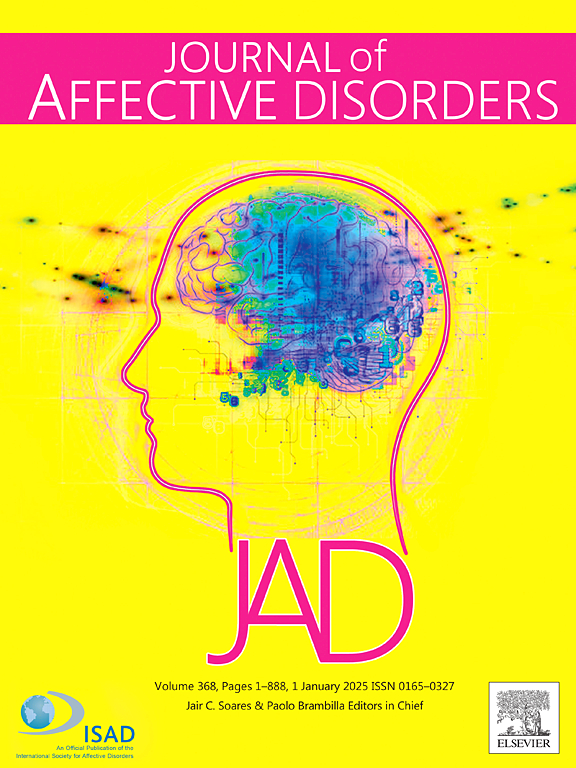Longitudinal association between stigma and suicidal ideation among patients with major depressive disorder
IF 4.9
2区 医学
Q1 CLINICAL NEUROLOGY
引用次数: 0
Abstract
Background
To explore the longitudinal associations between stigma and suicidal ideation among patients with major depressive disorder (MDD).
Methods
Data were from patients with MDD in the Depression Cohort in China. At baseline and weeks 4, 8, 12, 24, 48, and 72, the presence (yes and no) and severity (scores) of suicidal ideation were evaluated using the Beck Scale for Suicide Ideation, and stigma was assessed using the Depression Stigma Scale. Generalized linear mixed models were used to explore the association between stigma and suicidal ideation.
Results
Among 1123 patients with a mean age of 27.9 (SD, 7.3) years, 71.1 % were female. Restricted cubic splines showed positive linear dose-response associations of personal stigma and perceived stigma with the likelihood and severity of suicidal ideation. The adjusted ORs (95 % CIs) for each 10 score increment in personal stigma and perceived stigma were 1.49 (1.18, 1.89) and 1.46 (1.20, 1.77) for the likelihood of suicidal ideation, respectively. The adjusted β coefficients (95 % CIs) for each 10 score increment in personal stigma and perceived stigma were 0.222 (0.121, 0.322) and 0.202 (0.123, 0.281) for suicidal ideation scores, respectively.
Limitations
Information on sigma, suicidal ideation, and potential covariates was self-reported, so reporting bias was inevitable.
Conclusions
In this longitudinal study in patients with MDD, more severe personal stigma and perceived stigma were associated with a higher likelihood of suicidal ideation and more severe suicidal ideation. These findings suggest that reducing personal stigma and perceived stigma may help prevent suicidal behavior among patients with MDD.
背景:探讨重度抑郁症(MDD)患者的耻辱感与自杀意念之间的纵向联系:探讨重度抑郁症(MDD)患者的耻辱感与自杀意念之间的纵向联系:数据来自中国抑郁症队列中的重度抑郁症患者。在基线和第4、8、12、24、48和72周,使用贝克自杀意念量表评估自杀意念的存在(是和否)和严重程度(得分),并使用抑郁耻辱感量表评估耻辱感。研究采用广义线性混合模型来探讨耻辱感与自杀意念之间的关系:在平均年龄为 27.9(SD,7.3)岁的 1123 名患者中,71.1% 为女性。限制性三次样条显示,个人污名化和感知到的污名化与自杀意念的可能性和严重程度呈正线性剂量反应关系。个人成见和感知到的成见每增加 10 分,其自杀意念可能性的调整 ORs(95 % CIs)分别为 1.49 (1.18, 1.89) 和 1.46 (1.20, 1.77)。在自杀意念得分方面,个人耻辱感和感知耻辱感每增加 10 分,调整后的β系数(95 % CIs)分别为 0.222 (0.121, 0.322) 和 0.202 (0.123, 0.281):局限性:有关西格玛、自杀意念和潜在协变量的信息均为自我报告,因此报告偏差在所难免:在这项针对 MDD 患者的纵向研究中,更严重的个人污名化和感知到的污名化与更高的自杀意念可能性和更严重的自杀意念相关。这些发现表明,减少个人污名化和感知到的污名化可能有助于预防 MDD 患者的自杀行为。
本文章由计算机程序翻译,如有差异,请以英文原文为准。
求助全文
约1分钟内获得全文
求助全文
来源期刊

Journal of affective disorders
医学-精神病学
CiteScore
10.90
自引率
6.10%
发文量
1319
审稿时长
9.3 weeks
期刊介绍:
The Journal of Affective Disorders publishes papers concerned with affective disorders in the widest sense: depression, mania, mood spectrum, emotions and personality, anxiety and stress. It is interdisciplinary and aims to bring together different approaches for a diverse readership. Top quality papers will be accepted dealing with any aspect of affective disorders, including neuroimaging, cognitive neurosciences, genetics, molecular biology, experimental and clinical neurosciences, pharmacology, neuroimmunoendocrinology, intervention and treatment trials.
 求助内容:
求助内容: 应助结果提醒方式:
应助结果提醒方式:


